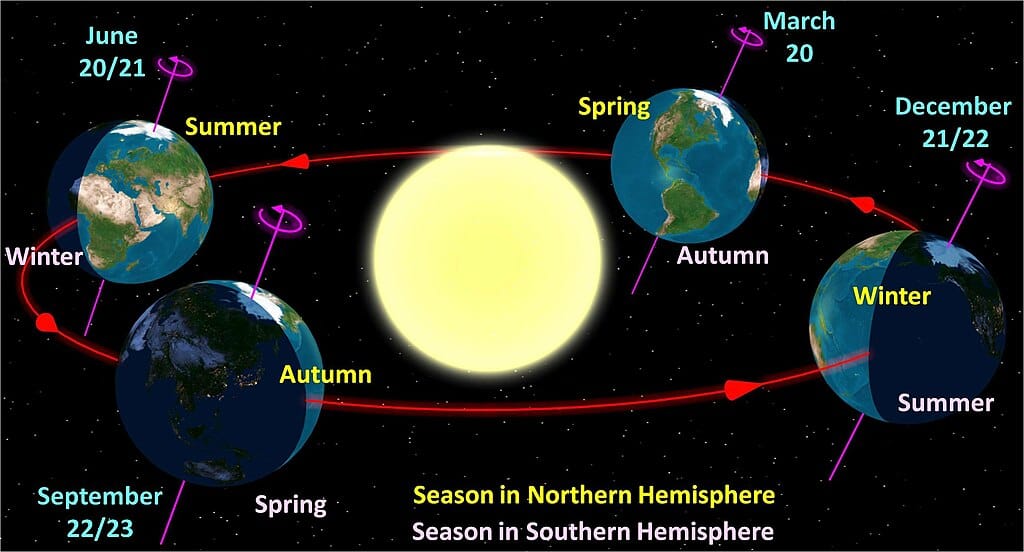equinox / equilux

The Encyclopedia of Astronomy & Astrophysics defines equinox as:
An instant at which the Sun crosses the celestial equator; the Sun is then vertically overhead at the equator, and day and night have equal duration at every point on the Earth’s surface. The apparent annual path of the Sun on the celestial sphere is inclined to the celestial equator and intersects it at two points. The terms vernal equinox and autumnal equinox are applied to these points.
The northern vernal/southern autumnal equinox occurs on 20 March, and the northern autumnal/southern vernal equinox occurs on September 22/23.
This definition is technically incorrect, although it serves accurately enough for most everyday purposes. The equinoxes are indeed the points when the Sun is directly over the equator, but day and night on this day do not have equal duration. The day in which they do is called the equilux.
Equinox is borrowed from the Latin aequinoctium, either directly or possibly via the Old French equinoxe. So equinox literally means equal night.
We see the word in Geoffrey Chaucer’s c. 1391 Treatise on the Astrolabe, albeit in a different sense. Chaucer uses to the word to refer to the constellations of Aries and Libra, the ones in which the sun appears when it is above the equator:
This same cercle is clepid also Equator, that is the weyer of the day; for whan the sonne is in the hevedes of Aries and Libra, than ben the dayes and nightes ylike of lengthe in all the world. And therfore ben these 2 signes called the equinoxiis.
(This same circle is also called the Equator, that is the measure of the day; for when the sun is in the heads of [i.e., is entering] Aries and Libra, then the days and nights are alike in length throughout the world. And therefore these two signs are called the equinoxes.)
The sense we know today is recorded some fifty years later in a Middle English translation of Palladius’s Opus agriculturae, also known as De re Rustica, a late fourth-/early fifth-century text on agriculture. In the section discussing the month of March, Palladius is translated as:
Til equynoxe is hemp ysowe as now
What lond is best for hit, & sedes geson
To sowe, in ffeueryeer is reson how.
(From now until the equinox is hemp sown. What is the best land for it and how to sow the seeds are the same as given for February.)
Day and night are not equal on the equinox for several reasons. For one, the sun is not a point source of light, it is, from the perspective of the Earth, a disc. Therefore, how one determines sunset and sunrise matter. Sunrise is generally determined when the upper limb of the sun first appears above the horizon and sunset when the upper limb disappears below it. But since the sun is a disc with an apparent radius of some 16 arcminutes, that means that means we see the sun’s light for about a half-hour longer on the equinox than the period for which we don’t. This is exacerbated by atmospheric refraction. The atmosphere bends the sun’s light, so we see the sun even when it is technically below the horizon. Finally, one’s position in one’s time zone relative to the position where the measurement of sunrise/sunset is taken also matters.
Hence, in recent decades astronomers have come up with the term equilux to mark the day on which one gets equal day and night. Equilux was formed in English from Latin roots, equi- + lux, literally equal light. In the northern hemisphere, equilux occurs a few days before the vernal equinox and after the autumnal equinox. This is reversed in the southern hemisphere. Exactly when the two equiluxes occur each year varies with location.
The earliest use of equilux that that I have been able to find is in a Usenet post on 14 March 1986:
This is just a friendly reminder that the spring equilux, the day when there are equal amounts of light and darkness, is approaching.
But now that you know this, if you’re tempted to correct someone when they say day and night are equal on the equinox, don’t. That’s just being an annoying pedant.
Sources:
Chaucer, Geoffrey. A Treatise on the Astrolabe. In The Riverside Chaucer, third edition. Larry D. Benson, ed. Boston: Houghton Mifflin, 1987, 1.17, 666.
Cheney, Bruce. “Spring Equilux Approaches ! Repent now !” Usenet: net.astro, 14 March 1986.
Middle English Dictionary, 2019, s.v. equinox, n.
Murdin, P. Encyclopedia of Astronomy & Astrophysics. Boca Raton, Florida: CRC Press, 2000, s.v. equinox.
Oxford English Dictionary, second edition, 1989, s.v. equinox, n.
Palladius. The Middle-English Translation of Palladius de re Rustica, Part 1—Text. Mark Liddell, ed. and trans. Berlin: E. Ebering, 1896, lines 4.64–66, 130. HathiTrust Digital Archive.
Image credit: Tau’olunga, 2006. Wikimedia Commons. Public domain work.